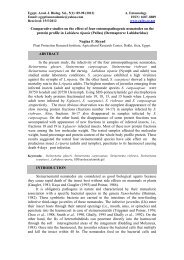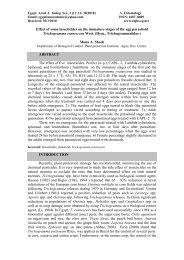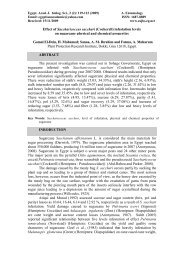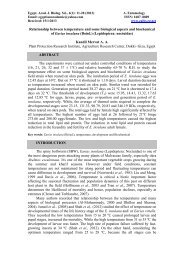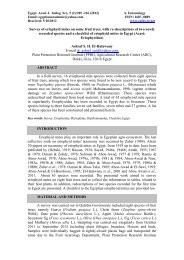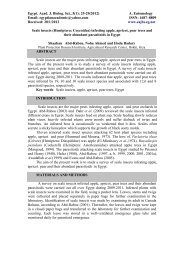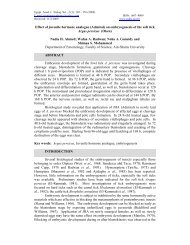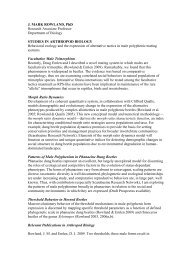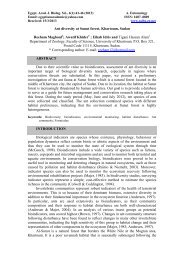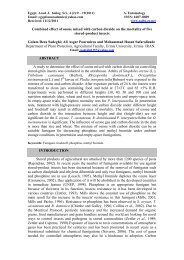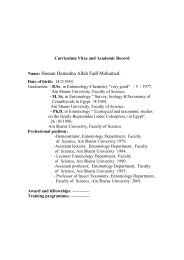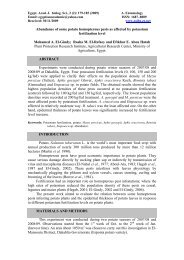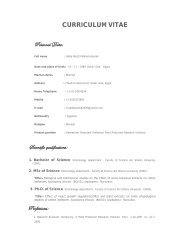Heat Requirements for the Development of the Black cutworm ...
Heat Requirements for the Development of the Black cutworm ...
Heat Requirements for the Development of the Black cutworm ...
You also want an ePaper? Increase the reach of your titles
YUMPU automatically turns print PDFs into web optimized ePapers that Google loves.
<strong>Heat</strong> <strong>Requirements</strong> <strong>for</strong> <strong>the</strong> <strong>Development</strong> <strong>of</strong> <strong>the</strong> <strong>Black</strong> <strong>cutworm</strong>, Agrotis ipsilon 123<br />
can be expressed by <strong>the</strong> <strong>for</strong>mula K = y (T– t0). George and phillip (1983) found that<br />
<strong>the</strong> developmental rates increased with increasing <strong>of</strong> temperature.<br />
R a t e o f d e v e l o(1/t p mx1 e0n 0) t<br />
Fig. (5): The regression line r a t e <strong>of</strong> o f d<strong>the</strong> e v erelation l o p m e n t between o f A . i p s i<strong>the</strong> l o n rate g e n e<strong>of</strong> r adevelopment t i o n a n d d i f f e <strong>of</strong> r e nA. t ipsilon generation<br />
c o n s t a n t t e m p e r a t u r e s .<br />
and different constant temperatures.<br />
The results in <strong>the</strong> present study are in agreement with Gergis et al.,<br />
(1990); Abdel-Hafez; Gergis et al., 1994, Dahi, 1997, Dahi 2005 and Dahi 2006..<br />
REFERENCES<br />
4<br />
3 . 5<br />
3<br />
2 . 5<br />
2<br />
1 . 5<br />
1<br />
0 . 5<br />
0<br />
r = 0 . 9 9 K = 5 7 5 . 3<br />
y = 0 . 1 7 4x<br />
- 1 . 8 3<br />
0 5 1 0 1 5 2 0 2 5 3 0 3 5<br />
T e m p e r a t u r e ( ° C)<br />
F i g . ( 5 ) : T h e r e g r e s s i o n l i n e o f t h e r e l a t i o n b e t w e e n t h e<br />
Abdel-Hafez, A.; S. H. Taher; G. M. Moawad and KH. GH. El-Malki (1993). The<br />
combined effect <strong>of</strong> high temperature and exposure period regimes on some<br />
biological aspects <strong>of</strong> pink bollworm Pectinophora gossypiella<br />
(Saund.).Egypt. J. Appl. Sci., 8 (7): 485-493.<br />
Blunk, M. (1923). Die Entwicklung Von Dytiscus marginalis L.Vom. Ei bis Zur<br />
Imago, 2 Teil. Die Metamorphase Zracht-Wiss. Sool, 121-171.<br />
Dahi, H. F. ( 1997). New approach <strong>for</strong> management <strong>the</strong> population <strong>of</strong> cotton<br />
leafworm Spodoptera littoralis (Boisd.) and pink bollworm Pectinophora<br />
gossypiella (Saund.) in Egypt. M. Sc. Thesis, Fac. Agric., Cairo University,<br />
149 pp.<br />
Dahi, H. F. (2003). Predicting <strong>the</strong> annual generations <strong>of</strong> <strong>the</strong> spiny bollworm Earias<br />
insulana (Boisd.) (Lepidoptera: Ar chtidae). Ph. D. Thesis, Fac. Agric.,<br />
Cairo Univ., 182 pp.<br />
Dahi, H. F. (2005). Egyptian cotton leafworm Spodoptera littoralis development on<br />
artificial diet in relation to heat unit requirements. Egypt. J. Agric. Res., 83<br />
(1):199-209.<br />
Dahi, H. F. and S. M. Abdel-khalek (2006). Threshold Temperature and Thermal<br />
requirements <strong>of</strong> <strong>the</strong> Lesser Cotton Leafworm Spodoptera exigua Hb. Bull.<br />
Ent. Soc. Egypt, 83: 271-281.<br />
Davidson, J. (1944). On <strong>the</strong> relation between temperature and rate <strong>of</strong> development<br />
<strong>of</strong> insects at constant temperatures. J. Anim. Ecol., 13: 26-38.<br />
George, C. R. and S. L. Phillip (1983). <strong>Development</strong>al rates <strong>of</strong> codling moth<br />
(Lepidoptera:Olethreutidae) reared on apple at four constant temperatures.<br />
Environ. Entomol., 12 (3) : 831-834.



